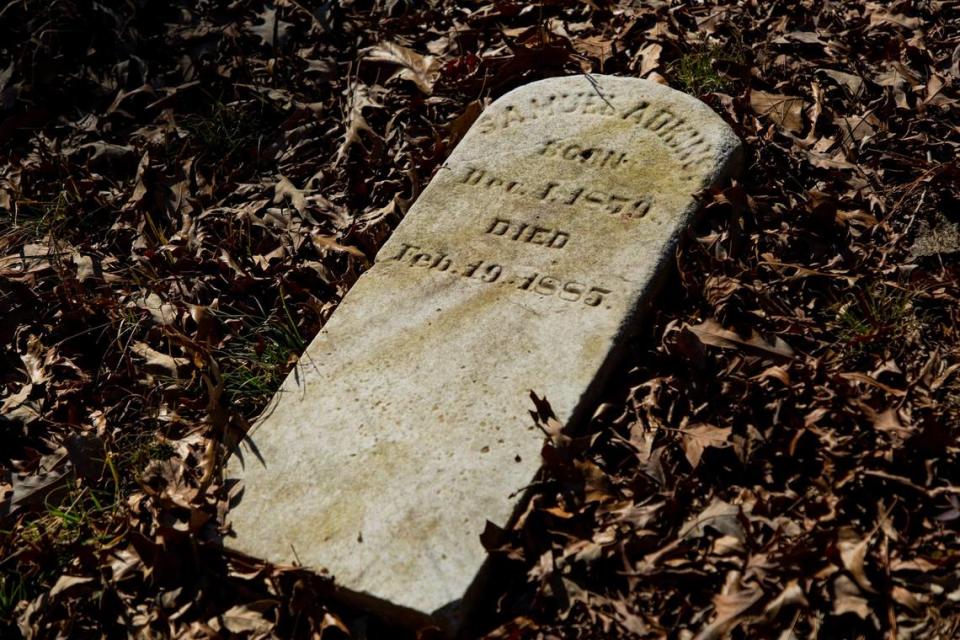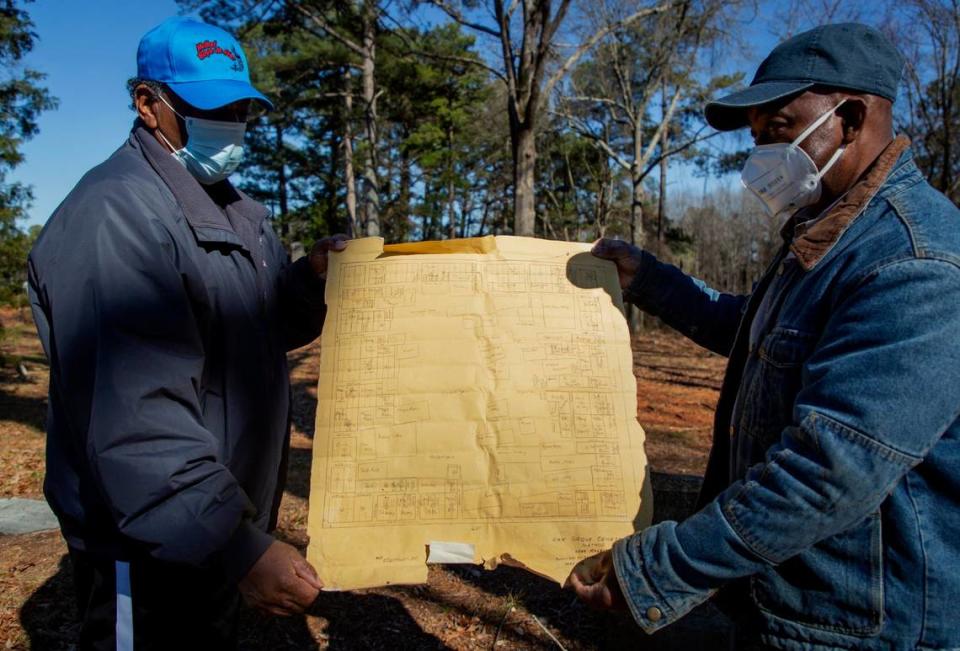Will historic designation protect this Black cemetery from Beltline construction?
Deborah Lofton and Ethel LaVerne Patterson raked oak leaves and pine needles from the graves of their ancestors last weekend and gathered up bouquets of last year’s faded plastic flowers, replacing them with bright new ones they had bought that morning.
Every Mother’s Day the cousins visit Oak Grove Cemetery and tend to the graves of parents, grandparents, aunts and uncles and great aunts and great uncles who lived in Method, the historic African-American community on the west side of Raleigh. Patterson said she couldn’t remember when the tradition started.
“I’ve been doing it all my life,” she said. “I’m 72.”
“How many years we been doing this?” she shouted to Lofton.
“All our lives,” Lofton, 58, shouted back. “I don’t know what’s going to happen when we’re gone.”
The shouting was necessary to be heard over the traffic rushing by on the Raleigh Beltline a few dozen yards away. The four-lane highway, which severed the cemetery from the rest of Method in the 1960s, has long been here in their memories.
But until this year, the passing cars were shielded from the cemetery by trees and brush, heard but not seen. Contractors recently cleared a path for construction equipment to add more lanes to the Beltline, thinning out or removing altogether the green wall that helped make the cemetery feel isolated.

“It was much more private,” Lofton said. “This year, all the privacy is gone. All you see is traffic.”
This stretch of the Beltline was the first to be built and is the last to be widened to six lanes to eliminate a bottleneck and replace outdated and dangerous interchanges. The N.C. Department of Transportation awarded a $347 million contract for the project two years ago, and construction is expected to last into the summer of 2023.
The construction has changed the feel of Oak Grove, exposing it to traffic. But the cemetery will be physically untouched, in large part because NCDOT works to avoid historic properties. The cemetery was added to the National Register of Historic Places in 2018.

“That is something we worked hard on getting done, to make sure it was a historical site,” says Rev. William T. Newkirk Sr. of Oak City Baptist Church, just up Ligon Street from the cemetery. “We’re hoping that will protect it.”
Signs of construction have arrived
Orange plastic construction fencing and wooden stakes in the ground between Ligon Street and the cemetery signal the start of utility work associated with the Beltline project. The one-lane tunnel that takes Ligon under the highway will be replaced by a two-lane bridge with sidewalks that will carry the street over it.
That will mean moving tons of dirt to build up the street on either side of the Beltline for a bridge that will rise up to 25 feet above the traffic. NCDOT engineer David Conner said the alignment of Ligon will be straightened out in a way that should reduce the street’s impact on the cemetery.

“There’s nowhere we’re really encroaching on the Ligon Street cemetery,” Conner said. “If anything, we’re moving away from it.”
The assumption among Method residents is that the bridge is needed to improve access to the N.C. State University research buildings that have grown up around the cemetery west of the Beltline. That may be true, but Conner says NCDOT is going over the highway because building another tunnel would require closing the highway for a while.
“Going over is a whole lot less inconvenient to the traveling public,” he said.
Method resident John Goode says members of the community were worried about Ligon Street and how the bridge would affect Oak Grove.
“They gave the community three choices on how to bring it over, because it was going to bring it pretty close to here,” Goode said, standing in the cemetery. “And we said, ‘No, no,’ and so they did change it. And hopefully, prayerfully, they’re going to stick to their word.”
A self-reliant African-American community
Oak City Baptist Church established Oak Grove Cemetery in the early 1870s in what was one of five villages created by freed African-Americans on the edge of Raleigh after the Civil War. Today, only two of those settlements — Method and Oberlin — survive in some form, and both have cemeteries on the National Register.
The church maintained the cemetery until 1937, when it was turned over to the Method Civic League so non-members could buy plots there. It was a gesture of self-reliance in a community where people built their own houses and raised their own food, Newkirk said.
“It’s just got a great history of people of color doing things for themselves,” he said. “For that reason, they decided they wanted their own cemetery as well.”
Method remains a majority African-American community, but that’s changing, Newkirk said. As succeeding generations of Black people move out, people from Latin America and South Asia have moved in, as have NCSU students; the Islamic Association of Raleigh mosque and school are a block from Newkirk’s church.

“It’s a very diverse community now. It’s no longer a Black community,” he said. “Which is good. But it has a very strong and proud history.”
A map of Oak Grove from 1938 shows neat rectangular plots laid out in groups on the cemetery’s edges, with several large areas closer to the center labeled “occupied space.” The oldest surviving marker, for Samuel Adkins who died in 1885, lies near the center, and seeing it makes it appear he was buried alone, in an otherwise empty part of the cemetery.
But as part the effort to have the cemetery nominated to the National Register, ground-penetrating radar was used to locate unmarked graves in 2016. New South Associates, the firm that did the survey, concluded that only 152 of the approximately 403 graves had markers and that people were buried in dense clusters throughout.

Rudolph Loftin Sr. inherited a copy of the 1938 map when he became the cemetery’s volunteer caretaker in 1967, when graves were dug by hand and the cemetery was still surrounded by woods and thickets. As families acquired plots, Loftin, now 94, wrote their names on the map that he passed on to the new caretaker, Albert Crenshaw, a few years ago.
Burials are rare these days, maybe one every few years. The newest headstones tend to be around the edges of the roughly one-acre square cemetery. Some of the older stones have been toppled over the years and some are too worn to read anymore.
Loftin says his wife, three of his sons and “a lot of friends” are buried in Oak Grove, and someday he and his surviving son will be, too. He said he knows of an old cemetery on nearby Blue Ridge Road that was moved to make way for a bank, which is why he helped get Oak Grove designated a historic site.
“If we had not had this as a historical site, this graveyard would have been gone. It would have been gone,” he said. “That’s why we worked hard to keep it up and let it be known that it was a sacred place.”

Oak Grove Cemetery was ‘home’
No one owns Oak Grove Cemetery; instead, individual families hold deeds to the pieces of ground where they are buried. Members of Method Boys to Men, a group of mostly retirees who grew up in the community, cut the grass and edge around the trees from time to time.
In the Jim Crow era, when the races were segregated even after death, people bought multiple grave sites for themselves and their children, to ensure they had a place to go. Amon Harris bought 12 plots for himself, his wife Mary Ida and each of their 10 children. Those plots are filled except for the one reserved for their youngest child, Clement, now 78.
Like many who grew up in Method, Clement Harris left to find his fortune elsewhere, settling in Rhode Island where he worked as a teacher. But he came home to Method when he retired. He describes the cemetery, by far the largest of two in Method, as home.
“It wasn’t a thing where you had to go to another place, or a better place, to be buried,” Harris said. “That was home. And that’s where everybody in the community went.”
Harris joined Lofton and Patterson as they tended family graves over Mother’s Day weekend. They’re all members of the Harris family. Ethel and Theodore Harris, grandparents to both Lofton and Patterson, were his aunt and uncle.
Lofton said that’s the way it is in Oak Grove, everybody seems to have some relation to someone else. When Harris paused at the grave of Everhardt Ligon, his third grade teacher who died in 1983, Lofton reminded him, “Miss Everhardt’s nephew married your sister.”
The Harrises aren’t the only ones who visit Oak Grove to tidy up and place fresh flowers and other mementos on the graves. A few feet from a row of Harris graves, someone had placed fresh plastic flowers next to the headstones of the Pope family, including a small wreath with “Hero” written on a ribbon on the grave of Wilbert J. Pope, an Army veteran of World War II who died in 1991.

“I went to school with some of their kids,” Patterson said. “There was a lot of them. It was a nice large family.”
Lofton paid special attention to the grave of Corina H. Edwards, their great aunt who taught sign language at the state school for the deaf and who died in 1985. Edwards never had children and treated all the kids in her extended family as her own.
It was Edwards who urged her family to care for the graves in Oak Grove, to honor and remember what they had been given by those who came before them.
“She made us vow to always clean up the cemetery,” Lofton said. “She didn’t want us to forget those who sacrificed for us.”

 Yahoo Finance
Yahoo Finance 